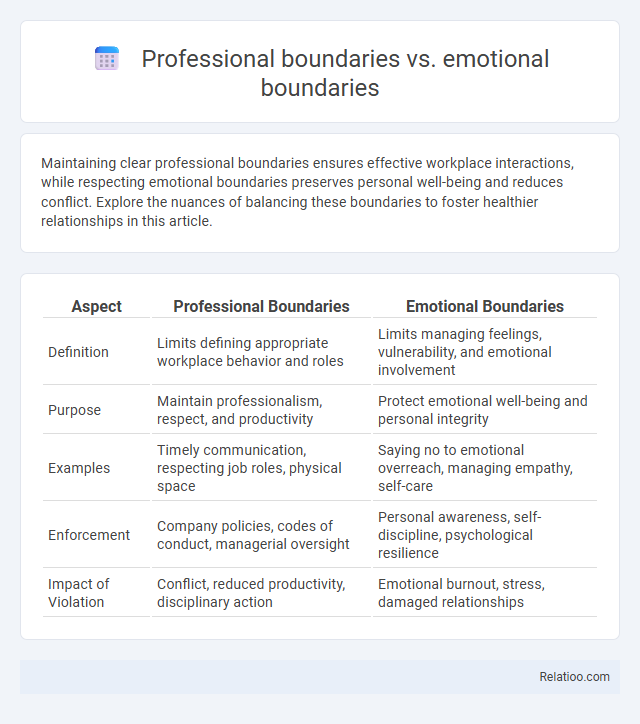Maintaining clear professional boundaries ensures effective workplace interactions, while respecting emotional boundaries preserves personal well-being and reduces conflict. Explore the nuances of balancing these boundaries to foster healthier relationships in this article.
Table of Comparison
| Aspect | Professional Boundaries | Emotional Boundaries |
|---|---|---|
| Definition | Limits defining appropriate workplace behavior and roles | Limits managing feelings, vulnerability, and emotional involvement |
| Purpose | Maintain professionalism, respect, and productivity | Protect emotional well-being and personal integrity |
| Examples | Timely communication, respecting job roles, physical space | Saying no to emotional overreach, managing empathy, self-care |
| Enforcement | Company policies, codes of conduct, managerial oversight | Personal awareness, self-discipline, psychological resilience |
| Impact of Violation | Conflict, reduced productivity, disciplinary action | Emotional burnout, stress, damaged relationships |
Understanding Professional Boundaries
Understanding professional boundaries is essential for maintaining a respectful and effective workplace, ensuring that interactions remain appropriate and focused on job-related responsibilities. Unlike emotional boundaries, which protect personal feelings and well-being, professional boundaries define limits on behavior and communication to prevent conflicts of interest and power imbalances. Clear professional boundaries enhance trust, encourage accountability, and support a healthy organizational culture.
Defining Emotional Boundaries
Emotional boundaries define the limits that protect an individual's emotional well-being by distinguishing personal feelings from others' emotions, ensuring healthy interpersonal interactions. Professional boundaries set clear limits in workplace relationships to maintain ethical standards and prevent conflicts of interest. Understanding and maintaining emotional boundaries helps prevent emotional exhaustion and fosters respectful, productive professional environments.
Key Differences Between Professional and Emotional Boundaries
Professional boundaries define appropriate limits in workplace interactions to maintain respect and productivity, while emotional boundaries protect your personal feelings and mental well-being from being compromised by others' emotions. The key difference lies in their focus: professional boundaries regulate external behavior and roles, whereas emotional boundaries manage internal feelings and emotional involvement. Understanding both helps you navigate relationships effectively without blending personal emotions into professional settings.
Importance of Setting Clear Boundaries in the Workplace
Setting clear professional boundaries ensures respectful and productive interactions among colleagues by defining acceptable behaviors and roles. Emotional boundaries protect employees from burnout and maintain mental well-being by preventing over-involvement in others' personal issues. Clear boundaries in the workplace foster a balanced environment that enhances communication, reduces conflicts, and improves overall job satisfaction.
Common Challenges in Maintaining Professional Boundaries
Maintaining professional boundaries often faces challenges such as blurred roles, emotional involvement, and unclear communication, which can lead to conflicts and ethical dilemmas. Emotional boundaries become difficult to uphold when personal feelings interfere with professional judgments, causing stress and reduced objectivity. Common issues include managing close relationships without favoritism, handling confidential information sensitively, and maintaining consistent standards in various work environments.
Signs of Blurred Emotional Boundaries at Work
Blurred emotional boundaries at work manifest through signs such as oversharing personal information, becoming overly involved in colleagues' personal issues, and difficulty separating work stress from personal emotions. Employees may experience heightened emotional reactions to workplace events, leading to impaired judgment and decreased productivity. Recognizing these signs helps maintain clear professional boundaries, ensuring a healthy workplace environment and emotional well-being.
Strategies for Establishing Healthy Professional Boundaries
Establishing healthy professional boundaries involves clear communication of roles and expectations, maintaining appropriate emotional distance, and consistently enforcing limits to protect both personal well-being and workplace productivity. Strategies include setting specific availability hours, using neutral language, and avoiding sharing overly personal information to prevent emotional entanglements. Regular training on boundary-setting and self-awareness practices enhances the ability to distinguish professional boundaries from emotional ones, fostering respectful and effective interactions.
Techniques for Strengthening Emotional Boundaries
Strengthening emotional boundaries involves techniques such as practicing self-awareness to recognize your feelings, setting clear limits on emotional involvement, and using assertive communication to express your needs without guilt. You can develop resilience by regularly engaging in self-care activities and reflecting on emotional triggers to maintain a healthy separation between personal emotions and professional interactions. Consistently reinforcing these strategies helps protect your emotional well-being while fostering balanced relationships in both personal and work environments.
Effects of Boundary Violations on Employee Well-Being
Boundary violations in the workplace can severely impact employee well-being by causing increased stress, burnout, and diminished job satisfaction. Professional boundaries ensure clear roles and responsibilities, while emotional boundaries protect personal feelings and prevent over-involvement or emotional exhaustion. Understanding the differences between professional boundaries, emotional boundaries, and specifically professional boundary breaches helps you maintain a healthy work environment and promote mental health among employees.
Building a Respectful Workplace Culture through Boundary Awareness
Building a respectful workplace culture requires a clear understanding of professional boundaries that define appropriate roles and behaviors to maintain productivity and hierarchy. Emotional boundaries protect individuals' feelings and maintain psychological safety, preventing personal issues from interfering with work relationships. Awareness and respect of both professional and emotional boundaries foster trust, reduce conflicts, and promote a collaborative environment essential for organizational success.

Infographic: Professional boundaries vs Emotional boundaries
 relatioo.com
relatioo.com